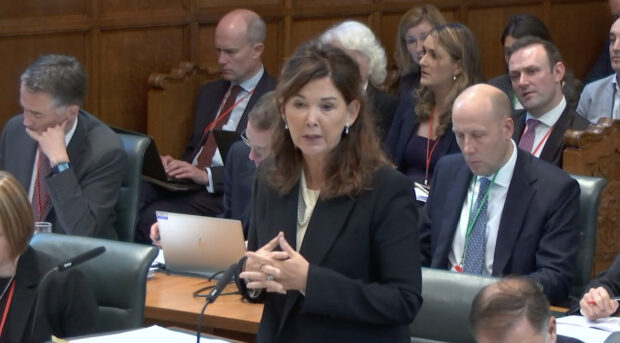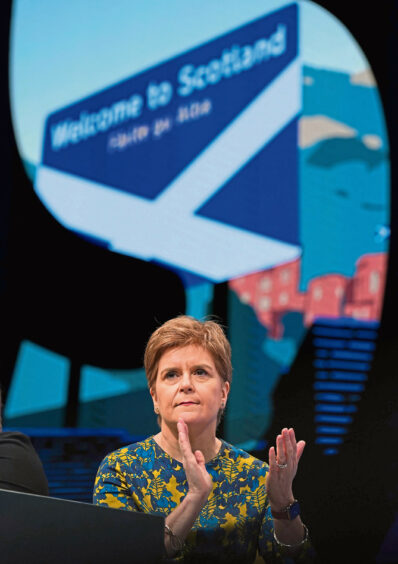
Nicola Sturgeon’s back-up plan to use an election as a de facto vote on independence has boxed her into a corner, according to constitutional expert James Mitchell.
On Wednesday, the UK’s highest court will deliver its judgment on whether the Scottish Parliament can legislate for a second referendum. A panel of five judges at the Supreme Court heard arguments from the Scottish and UK Governments in London last month.
Legal sources suggest the speed of the judgment means the ruling is likely to go against the Scottish Government.
Sturgeon has named October 19 next year as her preferred date for a poll but said she will treat the next General Election as a “de facto” referendum if the court rules that Holyrood cannot unilaterally call a referendum.
However, Mitchell, professor of public policy at Edinburgh University, said: “The first minister was so dismissive of anyone who dared to suggest a de facto referendum made little sense that it might be awkward for her to reverse her decision. But there are a lot of people in the SNP who think it is a mistake.
“The SNP does not seem ready to rush into a referendum and has clearly still got some big questions to address on the economy, pensions, borders and so on.”
Mitchell – who gave the inaugural State of Scottish Democracy lecture, hosted by the Electoral Reform Society last week – said: “If the SNP fights the next election solely on independence and fails to get 50% of the vote, what next? Does that put the issue back for a generation or are they going to fight on that issue at the next election after that?
“We may be at a point where people begin to tire of this and, in the context of the cost-of-living crisis, say we need to focus on public services, the economy, on the here and now.”
A Survation opinion last month suggested if an election were held tomorrow, 44% of Scots would vote for the SNP. However, only 35% wanted a referendum next year.
The Scottish Government said: “There is a substantial majority in the Scottish Parliament in favour of an independence referendum and therefore a clear democratic mandate.
“The Lord Advocate’s reference of this question to the Supreme Court was intended to achieve legal clarity on this point.”
The UK Government said: “Our clear view remains a Bill legislating for a referendum on independence would be outside the legislative competence of the Scottish Parliament.”
This ruling will signal a new phase in indy debate. Buckle up
By Andy Maciver
On the Sunday immediately preceding a referendum, or an election, or even a major political event like last week’s Autumn Statement by the Chancellor, we often feel the gravity of what is about to come.
Today, we are three days away from an event which could, in the final analysis, mark the most important moment in the Scottish independence debate since 2014. On Wednesday, the Supreme Court will decide whether the Scottish Independence Referendum Bill is within the competence of Holyrood.
In other words, it will decide whether the proposed second independence referendum, scheduled for October 19 next year, is legal. The judgment will push the start button on one of three potential scenarios, each of which could mark the beginning of the end of our interminable debate on whether or not Scotland should be an independent country.
The first is the one which most experts, and many non-experts, are deeming highly unlikely – that the Supreme Court will rule the referendum to be legal. The Scottish Government will, of course, have to press ahead with the vote.
The Labour party under Keir Starmer will, in my view, find it impossible to question the legitimacy of a vote which has been deemed legal by the Supreme Court, and will therefore also participate. The Conservatives, itching to urge a unionist boycott of the vote, will have an existential decision to make about whether it sides with the court or with the ultra-unionists whose votes it needs to remain any kind of force in Scottish politics.
However, if, as seems likely, the court says that calling a referendum is not within the competence of the Scottish Parliament, the response from the unionist parties is obvious. It is the response from the Scottish National Party, in particular, which is worthy of examination, and that response will lead to either the second or third of the possible scenarios.
The second scenario is the one which First Minister Nicola Sturgeon has already outlined as her back-up plan – to fight the next General Election as a proxy referendum. In other words, if 50% of the voters vote for a party advocating independence, it should be taken as a Yes vote (in reality, the strategy is that such an outcome will make the granting of a “legal” referendum by Westminster a fait accompli).
That strategy seems logical in the context of recent elections. With a weak Labour party, the SNP has been able to push independence as an alternative to the Tories.
However, the Labour party is no longer weak; it is strong, and very probably going to win the next election. Furthermore, the next election is highly likely to be focused on the cost of living crisis and the general economic outlook, making the likelihood of the SNP being able to fight a single-issue campaign rather small.
And, there, we reach the third possible scenario; that Sturgeon may have to decide discretion is the better part of valour. In other words, with polling indicating too little movement in pro-independence polling, might Sturgeon wait until 2026, on “home turf” at the next Holyrood election, to fight a proxy referendum at the ballot box?
Wednesday is the start of a new phase in the independence debate. Buckle up.
Andy Maciver is founder/director of Message Matters and Zero Matters

Enjoy the convenience of having The Sunday Post delivered as a digital ePaper straight to your smartphone, tablet or computer.
Subscribe for only £5.49 a month and enjoy all the benefits of the printed paper as a digital replica.
Subscribe
